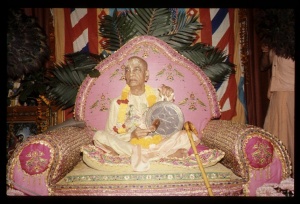SB 5.19.2: Difference between revisions
No edit summary |
(Vanibot #0054 edit - transform synonyms into clickable links, which search similar occurrences) |
||
| Line 23: | Line 23: | ||
<div class="synonyms"> | <div class="synonyms"> | ||
''ārṣṭi-ṣeṇena'' | ''[//vanipedia.org/wiki/Special:VaniSearch?s=ārṣṭi&tab=syno_o&ds=1 ārṣṭi]-[//vanipedia.org/wiki/Special:VaniSearch?s=ṣeṇena&tab=syno_o&ds=1 ṣeṇena]'' — Ārṣṭiṣeṇa, the chief personality of Kimpuruṣa-varṣa; ''[//vanipedia.org/wiki/Special:VaniSearch?s=saha&tab=syno_o&ds=1 saha]'' — with; ''[//vanipedia.org/wiki/Special:VaniSearch?s=gandharvaiḥ&tab=syno_o&ds=1 gandharvaiḥ]'' — by a company of Gandharvas; ''[//vanipedia.org/wiki/Special:VaniSearch?s=anugīyamānām&tab=syno_o&ds=1 anugīyamānām]'' — being chanted; ''[//vanipedia.org/wiki/Special:VaniSearch?s=parama&tab=syno_o&ds=1 parama]-[//vanipedia.org/wiki/Special:VaniSearch?s=kalyāṇīm&tab=syno_o&ds=1 kalyāṇīm]'' — most auspicious; ''[//vanipedia.org/wiki/Special:VaniSearch?s=bhartṛ&tab=syno_o&ds=1 bhartṛ]-[//vanipedia.org/wiki/Special:VaniSearch?s=bhagavat&tab=syno_o&ds=1 bhagavat]-[//vanipedia.org/wiki/Special:VaniSearch?s=kathām&tab=syno_o&ds=1 kathām]'' — the glories of his master, who is also the Supreme Personality of Godhead; ''[//vanipedia.org/wiki/Special:VaniSearch?s=samupaśṛṇoti&tab=syno_o&ds=1 samupaśṛṇoti]'' — he hears with great attention; ''[//vanipedia.org/wiki/Special:VaniSearch?s=svayam&tab=syno_o&ds=1 svayam] [//vanipedia.org/wiki/Special:VaniSearch?s=ca&tab=syno_o&ds=1 ca]'' — and personally; ''[//vanipedia.org/wiki/Special:VaniSearch?s=idam&tab=syno_o&ds=1 idam]'' — this; ''[//vanipedia.org/wiki/Special:VaniSearch?s=gāyati&tab=syno_o&ds=1 gāyati]'' — chants. | ||
</div> | </div> | ||
Latest revision as of 22:10, 18 February 2024

A.C. Bhaktivedanta Swami Prabhupada
TEXT 2
- ārṣṭiṣeṇena saha gandharvair
- anugīyamānāṁ parama-kalyāṇīṁ
- bhartṛ-bhagavat-kathāṁ
- samupaśṛṇoti svayaṁ cedaṁ gāyati
SYNONYMS
ārṣṭi-ṣeṇena — Ārṣṭiṣeṇa, the chief personality of Kimpuruṣa-varṣa; saha — with; gandharvaiḥ — by a company of Gandharvas; anugīyamānām — being chanted; parama-kalyāṇīm — most auspicious; bhartṛ-bhagavat-kathām — the glories of his master, who is also the Supreme Personality of Godhead; samupaśṛṇoti — he hears with great attention; svayam ca — and personally; idam — this; gāyati — chants.
TRANSLATION
A host of Gandharvas is always engaged in chanting the glories of Lord Rāmacandra. That chanting is always extremely auspicious. Hanumānjī and Arṣṭiṣeṇa, the chief person in Kimpuruṣa-varṣa, constantly hear those glories with complete attention. Hanumān chants the following mantras.
PURPORT
In the Purāṇas there are two different opinions concerning Lord Rāmacandra. In the Laghu-bhāgavatāmṛta (5.34-36) this is confirmed in the description of the incarnation of Manu.
- vāsudevādi-rūpāṇām
- avatārāḥ prakīrtitāḥ
- viṣṇu-dharmottare rāma-
- lakṣmaṇādyāḥ kramādamī
- pādme tu rāmo bhagavān
- nārāyaṇa itīritaḥ
- śeṣaś cakraṁ ca śaṅkhaś ca
- kramāt syur lakṣmaṇādayaḥ
- madhya-deśa-sthitāyodhyā-
- pure 'sya vasatiḥ smṛtā
- mahā-vaikuṇṭhaloke ca
- rāghavedrasya kīrtitā
The Viṣṇu-dharmottara describes that Lord Rāmacandra and His brothers—Lakṣmaṇa, Bharata and Śatrughna—are incarnations of Vāsudeva, Saṅkarṣaṇa, Pradyumna and Aniruddha respectively. The Padma Purāṇa, however, says that Lord Rāmacandra is an incarnation of Nārāyaṇa and that the other three brothers are incarnations of Śeṣa, Cakra and Śaṅkha. Therefore Śrīla Baladeva Vidyābhūṣaṇa has concluded, tad idaṁ kalpa-bhedenaiva sambhāvyam. In other words, these opinions are not contradictory. In some millenniums Lord Rāmacandra and His brothers appear as incarnations of Vāsudeva, Saṅkarṣaṇa, Pradyumna and Aniruddha, and in other millenniums They appear as incarnations of Nārāyaṇa, Śeṣa, Cakra and Śaṅkha. The residence of Lord Rāmacandra on this planet is Ayodhyā. Ayodhyā City is still existing in the district of Faizabad, which is situated on the northern side of Uttar Pradesh.